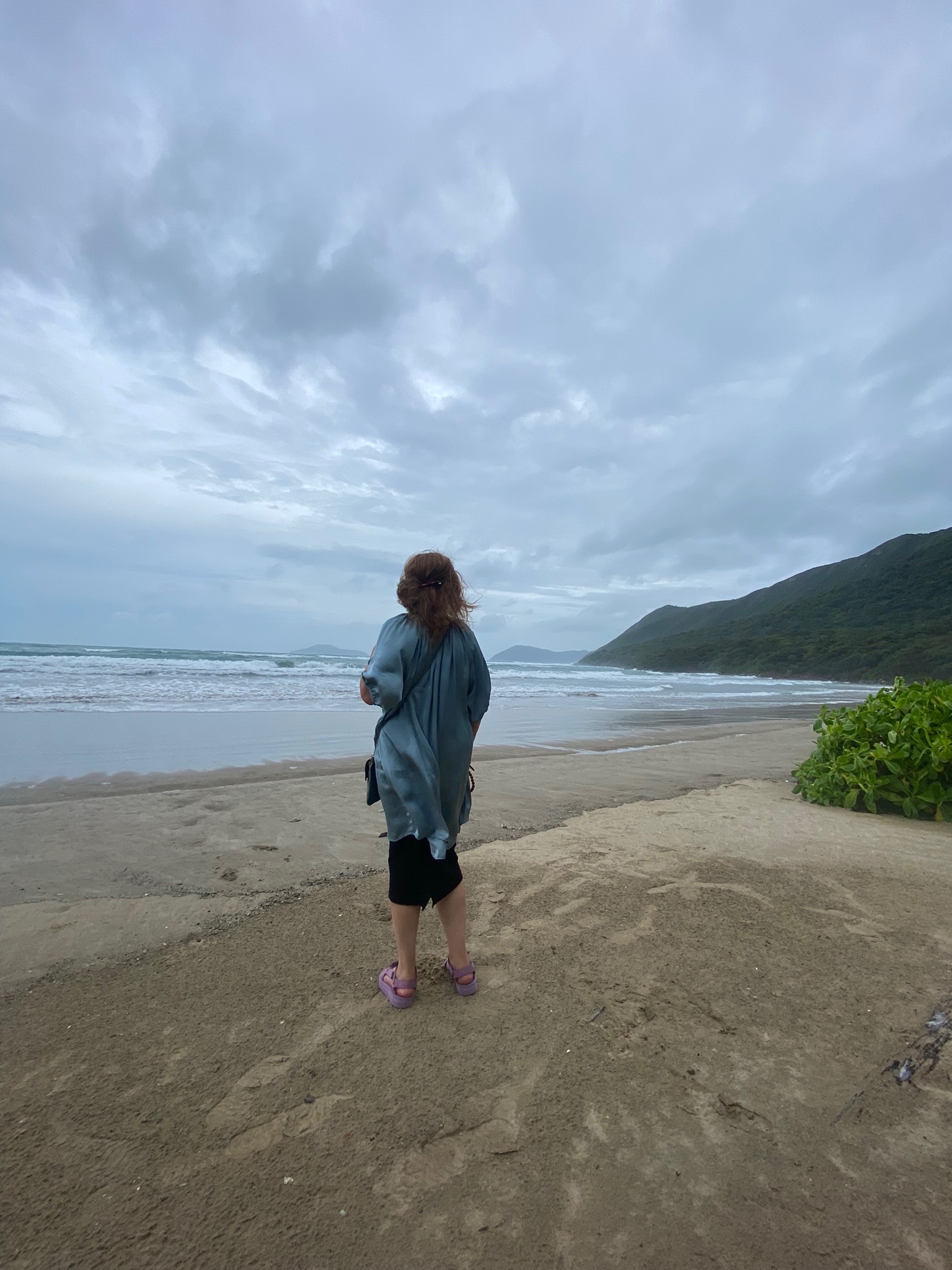Côn Đảo's Calling

Reasons to go to Côn Đảo - by guest blogger, Kirsty Denison

Côn Đảo is an island of day-job, desk-bound fantasies; a place where cloud-topped, jagged mountains encase bays of turquoise and paper-white sands. Just an hour's flight from frenetic Saigon, this 50km square patch of paradise is skirted by 15 other smaller islands and islets, making up the Côn Đảo Archipelago of South Vietnam's Vũng Tàu Province. This is a place at once warmly familiar and other-worldly exotic. The town-centre, with its dilapidated pale-yellow buildings and lamp-lit seafront promenade would not be out of place in Provence, and tell of a complicated past under French Colonial rule. Outside of this comfort-zone however sit the winding jungle-lined mountain paths and unbeatable beaches that make this the most absurdly spectacular place I've ever visited. As I walk you through the reasons I believe you should immediately hop aboard a plane here, I'll share some of the places and sites that made my five recent days here so incredibly memorable.
The Beaches
Imagine a Caribbean paradise beach; all multi-blued seas stretching out to a far-off horizon, cloudless skies, and sand softer than putty. Now take away all other tourists, any sounds and sights familiar to busy holiday destinations, and add a rich green backdrop of jungle wilderness: these are Côn Đảo's beaches, or at least the ones I found and fell in love with.
The Hidden Beach by Bai Dam Trau

Secret Beach
We climbed the stacked grey boulders on the left-hand side of Dam Trau beach, hoping for a better vantage point for pictures and general horizon-gazing. Feeling like adventurers, we reached the (very low) summit and congratulated each other before taking in the views. As Christopher Columbus must have felt when he set eyes upon America, there was a spring of excitement as we looked to the left, and upon what can only be described as every tourist's dream-find: a hidden cove completely devoid of other souls (a far-cry from the busy 'official' Dam Trau to our right). Two huge yellow buoys emblazoned with "Côn Đảo" sat on the shore, making this beach feel all the more strangely deserted. We'd somehow managed to arrive just in time at low-tide - 2pm the day we were there, but this of course varies - and the sea was far out enough for us to camp-out for a good few hours in a little tree-made cave to the right of the beach. With only the fish and a few strewn rocks for company, this little cove is as close to the deserted island fantasy as it comes.
[gallery type="square" ids="3077,3094"]
Getting here involves a multi-staged approach. First, make a spectacular drive along Co Ong Road, past the incredible panoramic sea views, until you reach a little white sign saying 'Bai Dam Trau'. Turn left, along a bumpy path until you reach some ramshackle huts servicing the 'official' Dam Trau beach. The women here will attempt to lure you with promise of fresh coconut juice and snacks, but resist - make your way left, scale the boulder's shallow heights, and there you'll find exactly what you've been looking for.
Six Senses Beach (Bai Dat Doc)

These are the sands Angelina Jolie and Brad Pitt walked upon during their 2011 stay on Côn Đảo, and you'd be forgiven for thinking that this stretch of beach would be off-limits to those paying less than a grand a night for accommodation. The Six Senses Resort seems exclusive in every sense of the word, but bizarrely its beach - or at least the end away from the villas - is open to us, the great unwashed.
[gallery type="square" ids="3089,3088,3797"]
To reach this piece of paradise, give the well-paved resort entrance a miss and continue along Co Ong Road until you see a large sign with some beach rules written in amusingly translated English. To the right there's a gap in the hedgerow, where a rocky slope leads down to the sands. You'll be greeted with everything you'd expect of a 5* beach; an almost people-less expanse of white sand, curving round to meet mountains that feel as though they're guarding the secrecy of this idyllic setting. There's some OK snorkelling to be done in the strangely warm, crystal-clear waters, but the pure relaxation and sense of achievement at freely roaming a first class beach is surely enough for most.
The Drives and the Dives

If viewed from above, Côn Đảo takes the shape of a dog side-on. The main road starts at the airport, the nape of the neck, and flows along the outer edges of the pup's underside. This is the kind of road that brings out the philosopher - and the adventurer - in everyone who has the sheer luck to pass along it. The front leg is rimmed with a mountain path looking out over the blue expanse of the South China sea, pleasingly interrupted by sight of the other islands. Wild jungle, and occasional pink blossom line the roads, and where there's not ocean scenes, there's great mounds of cloud-topped mountain in the distance to compensate. Sunsets - of the fast-moving, sky-burning kind - are best viewed from the south of the island, or the back of the dog's hind leg. Of course, the only way to really feel these rides with every sense is by motorbike, but there are (expensive) taxis on the island for those who daren't.
[gallery type="rectangular" ids="3099,3100,3098,3104"]
Along the east side of the island - the stomach, which seems appropriate - lies Côn Đảo's town, where you'll find a promenade, and neatly ordered, food-stall lined streets. Children, on a seemingly endless school-break, eat candy floss in among the battered French colonial buildings and towering palm trees. Motorbikes are almost outnumbered by pushbikes - something you can only dream of in nearby Saigon - and drives through the town are relaxing, especially in the evening.
[gallery type="rectangular" ids="3106,3107,3109"]
The Dives

Nothing much beats a boat trip across exotic waters, and if you're going to do it on Côn Đảo then it's best to do it right. Dive! Dive! Dive!, run by Côn Đảo guru Larry Bernier, is the most reputable on the island and operates a hand-built boat to sail you around the surrounding seas. Our trip took us to the south of Bay Canh Island, where turtles famously nest their eggs from May to November, and to the east side of Hon Tai (although trips vary depending on the day, and weather). Although my dodgy ears hampered my chances to dive, snorkelling was some of the best I've ever experienced; rich, vibrant coral circled by some incredible sea-life. My friend returned from a try-dive with a grin on his face, and an eagerness for more.
[gallery type="square" ids="3103,3102"]
The History
"Teacher, beware of the ghosts" said my students as I told them of my planned trip to Côn Đảo, such is this idyllic island's history (and infamous legend) as a brutal penal colony for, most recently, the French in the 1800s, and the Americans until as late as 1975. It is now considered one of the largest and most important historic sites in the country, as well as a memorial area for thousands of Vietnamese who come on pilgrimage to the island to pay their respects to the twenty thousand revolutionists and patriots who died at Colonialist and Imperialist hands. For foreign visitors, it can be hard for the mind to negotiate this horrific past with the tranquil nature of the island, though there are a few sites which can help the curious build a deeper understanding.

The prisons, all located along Ton Duc Thang and Nguyen Van Cuu Street, are a good place to start. Inside Phu Hai Prison, we found little in the way of information, just a courtyard flanked by ominous cells with scratched walls, hooks lining the edges presumably for the shackling of inmates. Our basic Vietnamese allowed my friends and I to locate a women's cell on the right side of the courtyard, used by the Americans for their hundreds of female prisoners. The French kept only one; the revolutionary Vo Thi Sau, who was imprisoned at 14, executed at 19, becoming a national martyr and hero in the process (her grave, along with thousands of others, are located at the Hang Duong Cemetery on Nguyen An Ninh Street where people go to light incense at midnight, and to generally pay their respects).
[gallery type="square" ids="3118,3121"]
With the help of workers who had congregated in the courtyard for lunch, we found our way to Phu Truong and the infamous “tiger cages”. Tiny cells with metal grilled ceilings are looked down upon from a walkway where guards would once have patrolled, throwing lime and faeces over the piles of inmates, often stabbing them with spears. Throughout the prison, stone replicas of guards and prisoners enact scenes of torture in place of detailed written explanations, and help to explain some of the brutality that went on here. For those who can face seeing the torture instruments and more gruesome descriptions of the abuse, there's a large museum on Nguyen Hue Street.
[gallery type="square" ids="3120,3117,3119"]

Workers show us out, revealing the stark contrast of the prison's exterior
Getting There
To experience Côn Đảo for yourself, the only real option is to fly with VASCO (a subsidiary of the more well-known Vietnam Airlines). For reasons unbeknownst to most, the cheapest tickets are to be found on a Thursday evening, so strategise your booking accordingly and go direct through the website. The flight's a beautifully short hour in a propeller plane (complete with complimentary water and wet-towels), flying low over Dam Trau beach for landing. Such is the remote nature of the island, accommodation is not as polished as on the mainland, but there's a good range of options (Con Dao Camping gets a personal recommendation on account of it being cheap, decent, and on the beach).
Côn Đảo is an island in the midst of change; get here now before masses of others discover this beautifully wild location.



